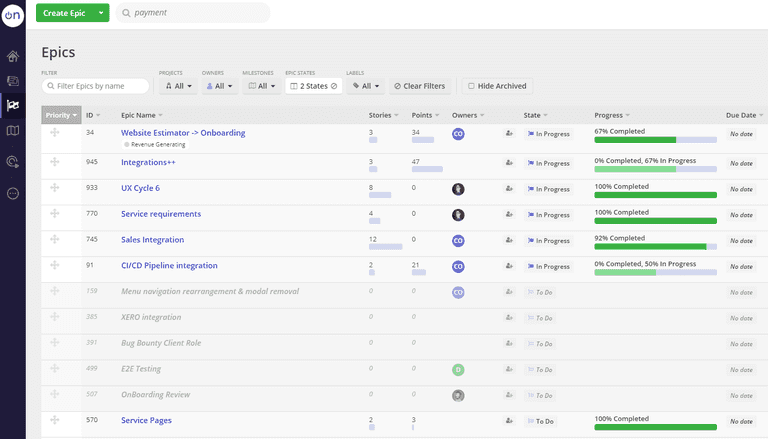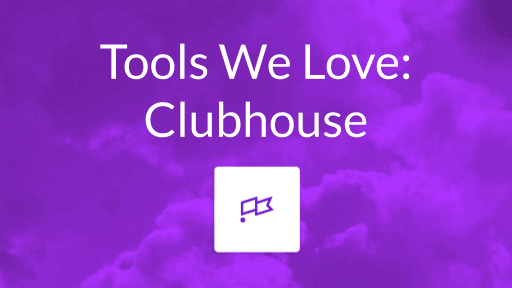
When we do our regular “tools we love” series here @ OnSecurity, we usually talk about hacking tools our pen-testers use for, er, hacking.
I wanted to change it up a bit this time around, and talk about Clubhouse, a tool we use as a business a LOT.
If you haven’t heard of it Clubhouse is a workflow or project management platform, designed for software teams.
I would describe it as a ‘pyramid’ system where you view a different layer of detail depending on what your role is, and the lower, more detailed layers feed up to the layers above them.
These layers are the core concept of Clubhouse (I love accidental alliteration (holy crap I just did it again!)). Briefly, they are as follows:
- Project - long-term or permanent projects (i.e. back-end dev, UX etc etc)
- Epic - large body of work which will deliver a new feature or component. Managers, product owners etc work at this level
- Story - The small components that make up a feature, this is the level the developers work at. Stories can be marked as a ‘feature’, ‘bug’ or ‘chore’.
Stories make up Epics, and Epics are assigned to a project.
The reason I wanted to blog about it is that Clubhouse has genuinely had a massive impact on the way we work here at OnSecurity. It has literally made this a nicer and better place to work, which I don’t often find myself saying about a B2B platform (the OnSecurity platform being the other exception of course! :P)
So why do we love Clubhouse so much?
We (like probably a lot of other early-stage companies) used to use Trello for working through stories and pushing out features.
As we grew, Trello boards quickly became messy and disorganized, we frequently found ourselves ditching entire boards and starting new ones in an attempt to regain some organisation, but the situation kept repeating itself and getting worse.
(Disclaimer: nothing against Trello, it’s a great tool and brilliantly implemented, it just wasn’t meeting our needs as we grew and there were more people doing more roles.)
Clubhouse, to me, is a bit like Trello, only it’s in 3D, and on Steroids.
It tells people at different layers of the organisation only what they need to know, when they need to know it. As a product person, I operate pretty much only at the “Epic” level - I don’t need to know the details of the individual stories the developers are working on, I just see the lovely “% complete” bar on my epics creeping up as the devs push stuff out.
We’ve found this a super-effective way of “Getting Sh*t Done”™ in product, and it just makes me feel good that I can check-in and see what’s happening without having to bother the developers. I switch off the laptop a happier man in the evenings.
Two P’s in a Pod (Productivity and Prioritisation)
Owners are assigned to everything within Clubhouse, so inherent accountability is introduced, which has had a very positive impact on productivity. The whole company can monitor what’s happening at the level and detail they care about. There are no features dropping off the face of the earth or not getting done for unexplained reasons. The communication tools built into Clubhouse mean developers can inherently keep managers updated at all times, for example by tagging in comments on stories. You can assign ‘due by’ dates to stories or epics, however we rarely do this to be honest, unless it’s an urgent bug.
Another nice feature is the ability to easily prioritise epics (and therefore stories), so that when the goals or priorities or the organisation change, you can feed that down to developers by dragging and dropping Epics. That is epic.
Pushing the boat out
The product team found the platform worked so well that we pushed it out to other areas of the business. It is now used heavily by Sales, Marketing and (soon) Customer Success.
Taking marketing as an example, for each blog post we create an Epic. The epic is made up of stories consisting of the steps involved in researching, writing, publishing, publicising and measuring the success of the post. These steps are repeatable, so we just recycle this epic for each new blog post.
The marketing manager only cares about the completeness of the Epic, the stories are each assigned to the people best placed to carry them out, and Sh*t Gets Done™.

Conclusion
Well, it’s probably fairly obvious from above that I’d strongly recommend you at least give Clubhouse a try - they now have a free tier so you can use a very full set of features, completely free, for up to ten users. There’s a tonne of other features I haven’t mentioned in this post, but hopefully you get the message. Try it out anyway and see what you think - we haven’t looked back!
What tools do you use in your company that have had a big impact on your operations, culture or even margins?
Note: OnSecurity is in no way affiliated with Clubhouse (bar the obvious fact that we use it religiously). My friend Al now works there as a designer or illustrator or something (check out his Dribbble), but I don't like him anywhere near enough to publicise his employers for no reason. I'm writing about Clubhouse here because we like to tell people about tools that are going to help them achieve their goals.




